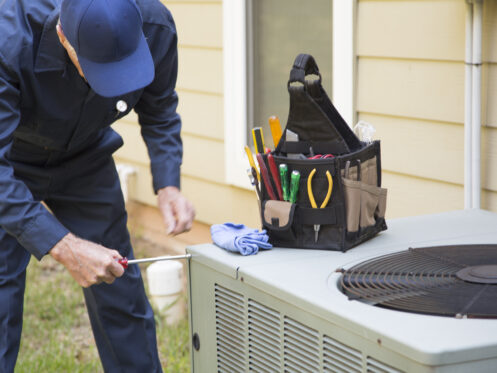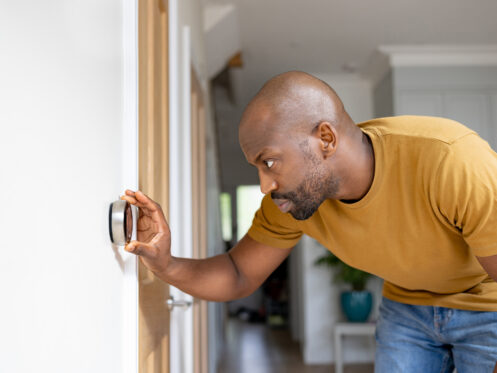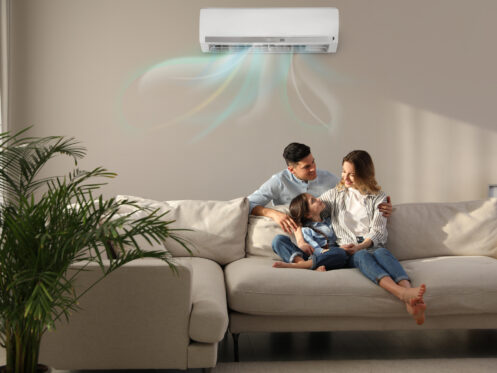Central air conditioning is one of the many home systems that we rely on to provide us with adequate comfort during the summer months. Unfortunately, most of us can’t describe just how these systems work. It’s vital to understand how your air conditioner works so that you can perform necessary preventative maintenance and fix small issues.
It’s All About Heat Transfer
Many of us are stuck on the idea that air conditioners put coolness into the air. This isn’t exactly how they work. Air conditioners should be thought of as heat transfer systems. They work by removing heat and humidity from the air inside of our homes. This removal of heat and humidity is what provides a feeling of coolness that we all look forward to on a scorching hot day.
Humidity is a big contributor to an uncomfortable home environment in the summertime. This is because when there is excess moisture in the air, there is less space for the sweat that your body produces to be evaporated into the air. This leaves your skin feeling clammy and sweaty.
Thermostat
Your home’s thermostat is what signals the rest of the air conditioning unit to turn on and off. You can set your thermostat to the desired temperature, like 78 degrees Fahrenheit. When the thermostat senses that the temperature in your home is above your set temperature, in this case, say 80 degrees, it will signal to both the indoor and outdoor air conditioning units to turn on.
It’s very convenient to have a programmable thermostat. This allows you to set different desired indoor temperatures through the various days and times of the week. For example, you can set the temperature to be 78 degrees at times you know that your family will be home. And, you can set it to go up to 88 degrees when you’re not home to save yourself money on energy bills.
Air Filter
The air will be pulled through an air filter. Some bigger air conditioning systems will have multiple air filters. This filter is an imperative part of your system that determines the quality of your indoor air. Traditionally, the filter is designed to remove unwanted pollutants and allergens from the air.
There are various types of air filters that you can purchase. The most common are pleated air filters that remove a large portion of dust and other debris in your home’s air. However, if you have younger family members or ones that have bad allergies, you may want to consider investing in a HEPA air filter. This type of filter removes 99.97 percent of airborne particles.
Your air filter should be replaced at least once every three months. It’s best to evaluate its condition once per month. When you get to the point where you can no longer clearly see through your filter when you hold it up to a light source, it’s time to replace it.
Air Purifier
If you opted to have an air purifier installed as part of your centralized air conditioning system, it will be placed in the return air ducting. There are four different types of air purifiers that you can have installed in your system. These include media filters, electronic purifiers, photocatalytic oxidation (PCO) purifiers, and combination units.
Media filters are going to be the least expensive, while combination units are going to be the most expensive. PCO units are recommended for homes that have odor problems as they work to eliminate many nasty home odors. Electric air purifiers are best for homeowners that don’t want to deal with replacement filters as these units use electricity to eliminate unwanted bacteria and viruses from your home.
Air-Handling Units
When the thermostat kicks on your air conditioning system, it will start with the air-handling unit. This unit is responsible for pulling air from inside of your home into the return air ducting. The ducting is connected to the indoor air conditioning unit.
Evaporator Coil
Once the air passes through your air filter, it will be directed over the evaporator coil. This is a copper coil that contains a substance known as refrigerant. As the warm air passes over the evaporator coil, the heat is transferred to the liquid refrigerant. The refrigerant then changes from a liquid to a gaseous state.
During this process of heat transfer, some of the excess humidity in the air is removed. The water will fall off the evaporator coil and into the drain pan. It will then be removed through the drain. Once the heat is removed from the air after going over the evaporator coil, it’s sent back to the supply vents throughout your home.
Refrigerant
Now that the heat was transferred from the air to the refrigerant and the refrigerant was turned into a gaseous state, it heads to the outdoor unit via insulated copper tubing. The compressor in the outdoor unit pressurizes the refrigerant vapor.
Fins
A fan in the outdoor unit forces cool air over the refrigerant tubing. In addition, the metal fins connected to the tubing help to disperse the heat from the refrigerant. During this process, the refrigerant is turned back into a liquid state. It’s then returned into the indoor unit via the insulated copper tubing.
Expansion Device
As the refrigerant enters back into the indoor unit, it will go into an expansion device. This device helps to regulate the amount of liquid refrigerant that can flow into the evaporator coil. Once the refrigerant enters into the evaporator coil, the process starts all over again.
Types Of Home Air Conditioning Systems
There are three main types of centralized home air conditioning systems. These include split systems, packaged systems, and ductless systems. Traditionally, split systems are highly recommended for any home that has existing ductwork. These systems have independent heating and cooling units.
Packaged systems are best for homes that don’t have a lot of excess crawlspace for both heating and cooling equipment. These packaged systems have both heating and cooling components combined into one unit. The unit is placed outside, which makes it more susceptible to adverse weather conditions.
Ductless systems are ideal for homes that don’t have any existing ductwork present. After a home is constructed, it’s not financially feasible to install ductwork. For this reason, ductless units are the best option. These are comprised of wall-mounted heating and cooling units that are connected to an outdoor compressor unit via insulated copper tubing. Each unit operates individually, allowing for the major benefit of zone cooling and heating.
Reliable AC Services
When it’s time to get your air conditioning system serviced, you need a professional that you can rely on in Jacksonville, FL. Buehler Air Conditioning & Plumbing has trained technicians that can assist you with all of your cooling, heating, air purification, and duct cleaning needs. Give us a call today and we’ll get a technician on the way.



